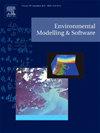Unveiling uncertainties in soil organic carbon modeling: the critical role of climate response functions
IF 4.6
2区 环境科学与生态学
Q1 COMPUTER SCIENCE, INTERDISCIPLINARY APPLICATIONS
引用次数: 0
Abstract
Accurately simulating soil organic carbon (SOC) dynamics is essential for carbon-related assessments. Process-oriented SOC models employ temperature (f(T)) and soil moisture (f(W)) response functions derived from specific conditions to simulate SOC responses to climate change, yet are widely applied in regional and global-scale studies. How these functions affect regional SOC simulations remains unclear. We evaluated the impacts of ten f(T) and nine f(W) functions using the Double Layer Carbon Model (DLCM) in the Qinling Mountains from 1982 to 2018. After calibration by Particle Swarm Optimization, DLCM estimated initial SOC with high spatial consistency (R2 > 0.9) and less than 1 % bias against machine learning based baseline maps over 85 % of the area. Different functions led to large SOC variations (up to 37 % in topsoil and 30 % in subsoil). Their combined impacts vary significantly under climate fluctuations, highlighting the need for accurate functions to improve SOC prediction in a changing climate.
揭示土壤有机碳模型中的不确定性:气候响应函数的关键作用
准确模拟土壤有机碳动态是碳相关评价的基础。面向过程的有机碳模型利用特定条件下的温度(f(T))和土壤湿度(f(W))响应函数来模拟有机碳对气候变化的响应,目前已广泛应用于区域和全球尺度的研究。这些功能如何影响区域SOC模拟尚不清楚。利用双层碳模型(DLCM)评价了1982 - 2018年秦岭地区10个f(T)和9个f(W)函数的影响。经粒子群算法校正后,DLCM估计的初始SOC具有较高的空间一致性(R2 >;0.9),对85%以上区域的基于机器学习的基线地图的偏差小于1%。不同功能导致土壤有机碳含量的变化较大(表层土壤最高可达37%,底土最高可达30%)。它们的综合影响在气候波动下变化显著,因此需要精确的功能来改善气候变化下的有机碳预测。
本文章由计算机程序翻译,如有差异,请以英文原文为准。
求助全文
约1分钟内获得全文
求助全文
来源期刊

Environmental Modelling & Software
工程技术-工程:环境
CiteScore
9.30
自引率
8.20%
发文量
241
审稿时长
60 days
期刊介绍:
Environmental Modelling & Software publishes contributions, in the form of research articles, reviews and short communications, on recent advances in environmental modelling and/or software. The aim is to improve our capacity to represent, understand, predict or manage the behaviour of environmental systems at all practical scales, and to communicate those improvements to a wide scientific and professional audience.
 求助内容:
求助内容: 应助结果提醒方式:
应助结果提醒方式:


